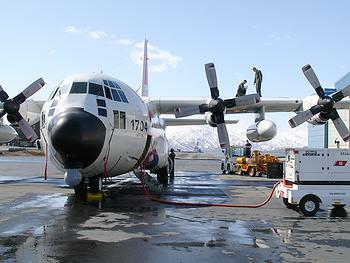 由於人類造成的氣候變遷現象,導致埋在冰封的北極凍土下幾十億噸的碳受到升溫的影響而釋出。為了測量釋出的溫室氣體類別和數量,從現在到11月間,官部門的科學家將乘坐載滿儀器設備的飛機橫渡凍土地帶。
由於人類造成的氣候變遷現象,導致埋在冰封的北極凍土下幾十億噸的碳受到升溫的影響而釋出。為了測量釋出的溫室氣體類別和數量,從現在到11月間,官部門的科學家將乘坐載滿儀器設備的飛機橫渡凍土地帶。
科學家們表示,最近的觀測結果顯示阿拉斯加上空的空氣「似乎已出現了區域性溫室氣體排放增加的初步跡象」,可能導致全球氣候變遷。
「最近的觀測結果也許只是只偶發的現象,也可能是大區域性溫室氣體排放量改變的一部分。而此變化有可能會使得氣候暖化的進程加速到難以駕馭的地步。」美國國家海洋暨大氣管理局(NOAA)科羅拉多州博爾德市的地球系統研究實驗室的斯威尼(Colm Sweeney)表示:「我們尚未掌握詳情,但我們非常迫切地想釐清其來龍去脈。」
斯威尼負責一項用飛機在全國各地採集溫室氣體樣本的計劃。此外,該實驗室還同時監測全球達60個地點的溫室氣體狀況。
她還表示:「找到天然的排放源,並且測量目前已被釋放出來的甲烷和二氧化碳量,以便事先察覺到排放量增加的跡象是很重要的。雖然溫室氣體甲烷存留在大氣中的時間遠不如二氧化碳,但甲烷卻比二氧化碳威力強25倍。正因爲這樣,我們對這些天然的排放源特別感興趣。」
斯威尼說:「布魯克斯(Brooks)山脈北方的凍土尚未融化,但部分該山脈南部的地區已經出現融冰的現象。而南部山區的狀況將為未來數年北部山區可能發生的現象提供諸多線索。」
斯威尼和他的團隊對暖化的凍土未來是否會乾涸,並釋出大量的溫室氣體二氧化碳感到好奇。或者他們也想知道,融化後的雪水是否會形成池子和湖泊、淹沒在水中的有機物質成爲微生物的食物來源、釋出大量的甲烷--另一種溫室氣體。
較早的研究曾經記錄北極附近的湖泊出現大的甲烷氣泡。衛星傳感器在其他地區也曾發現類似的湖泊,但至於這些湖泊是否有出現甲烷就不得而知。
去年在北極海洋的科考船觀測到甲烷噴口從海底釋出氣體。科學家表示,也許這些噴口一直以來就在那裏,只是沒被發現,又或者是最近才形成的。
這些花了約3個季度搜集而來的數據將有助於NOAA找出天然排放的地點、估算流量,並為未來即將發生的變化設置比對基準。
Billions of tons of carbon are buried in the frozen Arctic tundra, now heating up because of human-caused climate change. To measure which greenhouse gases are being released and in what quantities, government scientists are flying instrument-laden planes over the tundra from now through November.
They say recent observations indicate that the air above Alaska "may already hold the first signs of a regional increase in greenhouse gas emissions" that could contribute to global climate change.
"Recent observations could be isolated cases or part of a vast regional change in emissions that could accelerate climate warming to a more dangerous pace. We don't know yet," said Colm Sweeney, of NOAA's Earth System Research Laboratory in Boulder, Colorado. "We're eager to find out."
Sweeney heads a NOAA aircraft project that samples greenhouse gases around the country. In addition, the lab monitors the gases from 60 sites worldwide.
"It's important to locate natural sources and measure how much methane and carbon dioxide are being released now so we can watch for signs of increasing emissions," said Sweeney. "Methane is 25 times more powerful than carbon dioxide as a greenhouse gas, though its lifetime in the atmosphere is significantly shorter. We're especially interested in those sources."
"North of the Brooks Range, the tundra is not yet melting, but south of the range, partial melting is already occurring,"
Sweeney said. "The south will give us clues to what's likely to happen north of the range in the coming years." Sweeney and his team want to know if in the future the warming tundra will dry out, exhaling large amounts of the greenhouse gas carbon dioxide. Or, they wonder, will melting ice form pools and lakes, allowing microbes to eat buried organic matter, burping up huge amounts of methane, another greenhouse gas.
Earlier research documented large bubbles of methane near Arctic lakes. Satellite sensors revealed similar lakes in other areas, but whether those lakes produce methane is unknown.
Last year research vessels in the Arctic Ocean observed methane vents releasing the gas from the ocean floor. Perhaps these vents have been there all along, undiscovered, say the scientists, or they could have developed recently.
Gathered over three seasons, the data will help NOAA map out natural emissions sites, estimate their outflow, and set benchmarks for future changes.



